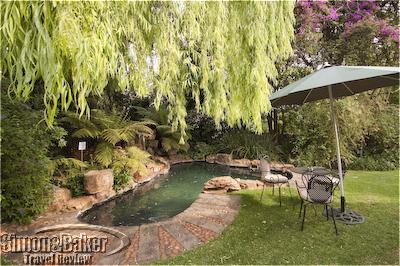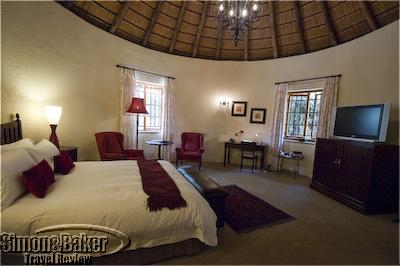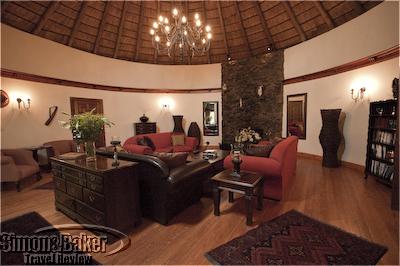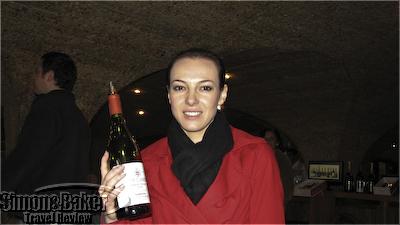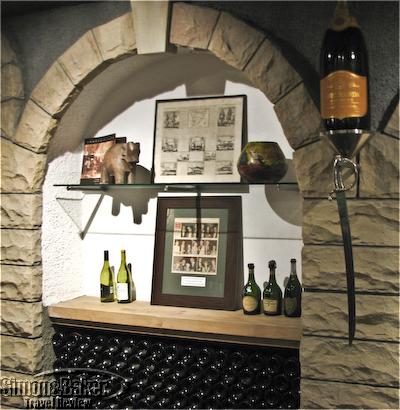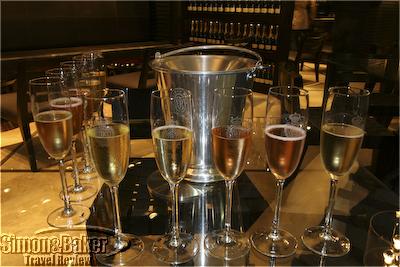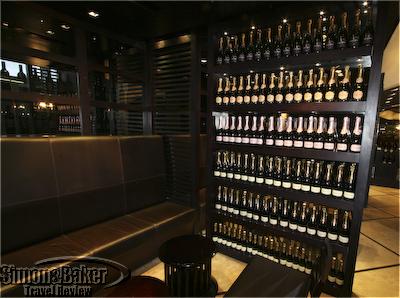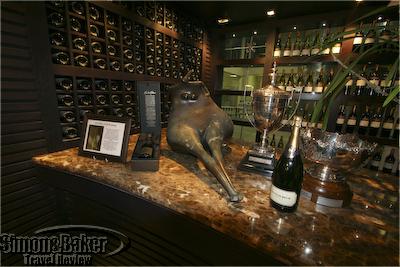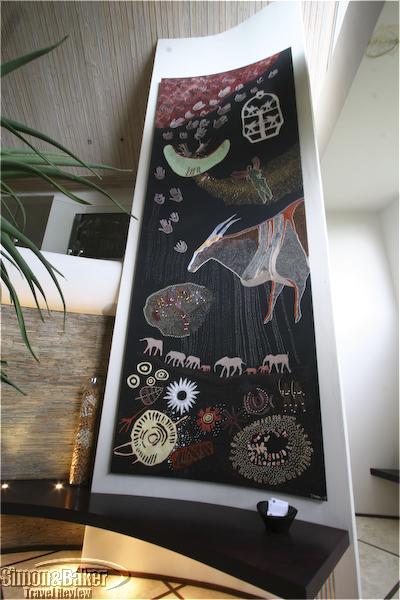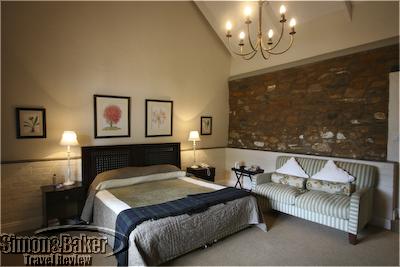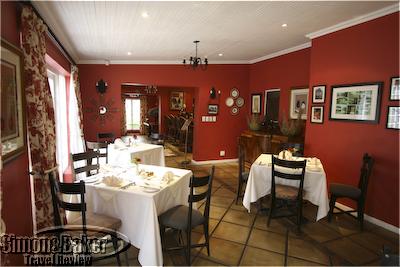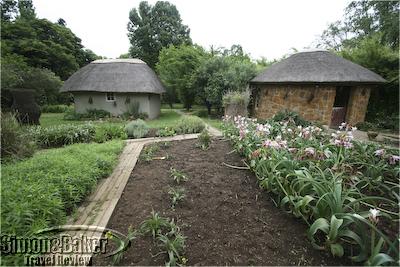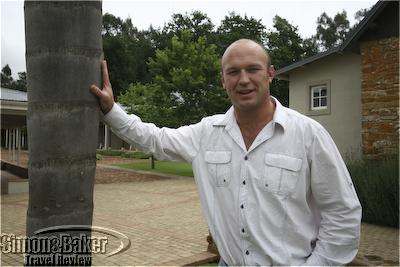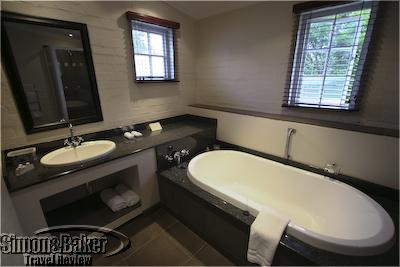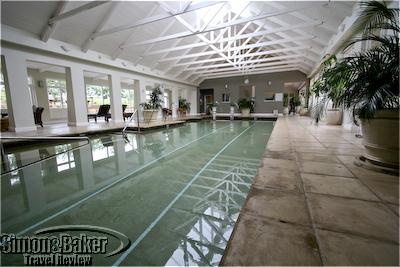by Editor | Feb 22, 2010 | Restaurants
By Elena del Valle
Photos by Gary Cox
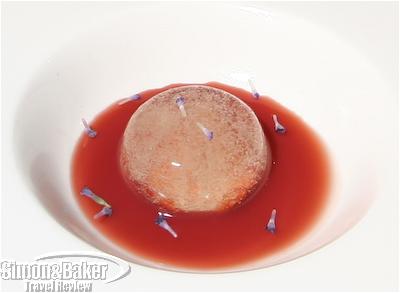
Champagne and Lavender Jelly at The Greenhouse
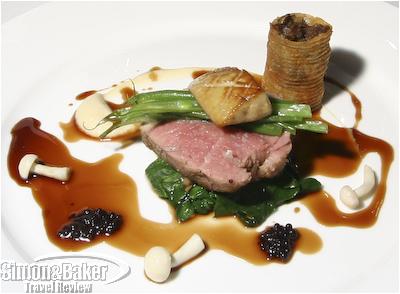
Grain Fed Beef Filet
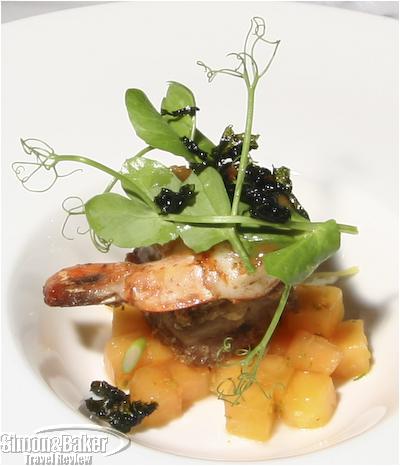
Our favorite dish: Malay Spiced Prawns and Pork Belly
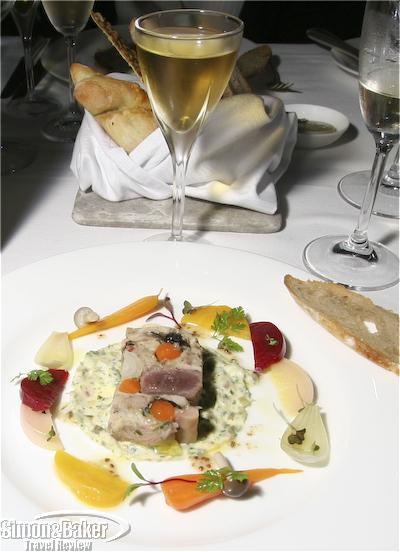
Game Terrine
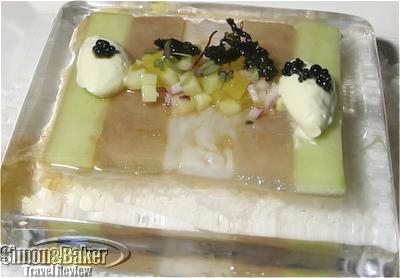
Carpaccio of Scallops, Tuna and Abalone
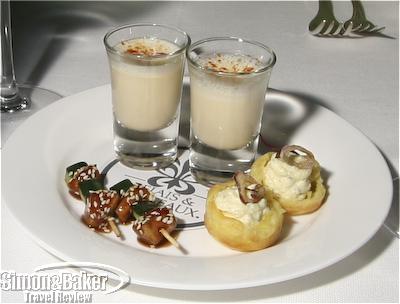
Amouse bouche
When we confirmed our stay at Madiba Villa at the Cellars-Hohenort Hotel in Constantia we were pleased. In part because we were looking forward to staying in the two-bedroom villa on the outskirts of Cape Town; and in part because we were looking forward to revisiting The Greenhouse, one of our favorite restaurants in that South Africa city.
Although we missed Chef Rume Booyens’ touch (she had been the chef when we first visited the restaurant) our Tasting Menu dinner at The Greenhouse was a treat. We are confident the restaurant will remain outstanding since the restaurants at the Relais & Chateaux hotel and its two sister properties remain under the watchful eye of Peter Tempelhoff, executive chef for The Collection by Liz McGrath.
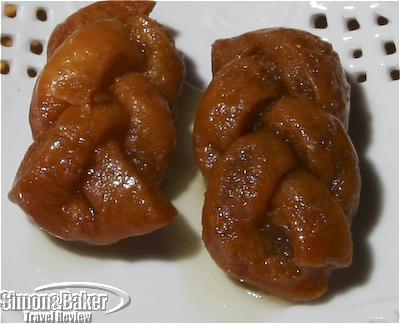
Sweets at The Cape Malay Restaurant

The staff surprised us with a Happy Birthday petit four plate at The Cape Malay
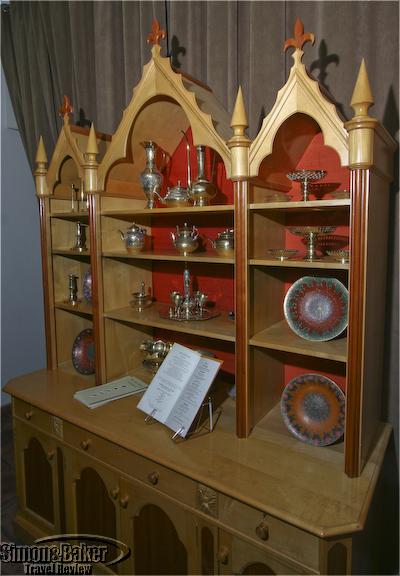
The eastern decor at The Cape Malay
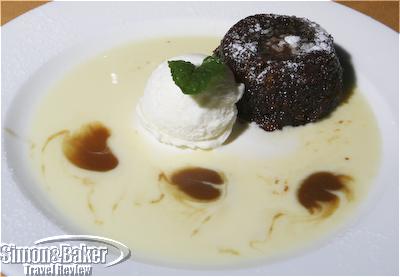
Dessert at The Cape Malay
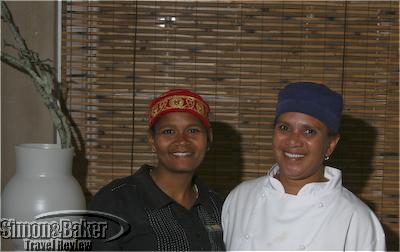
At The Cape Malay Restaurant, Cynthia was our server and Jasmin cooked
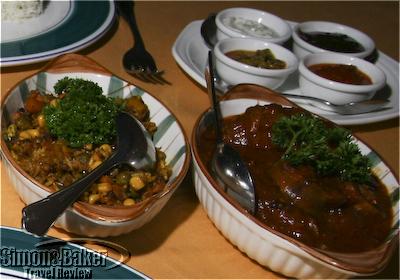
Mains at The Cape Malay
At The Greenhouse we had the Tasting Menu: Carpaccio of Scallops, Tuna and Abalone with a 2005 Klein Constatia Estate Brut MCC; Game Terrine with a 2000 Nederburg Auction Reserve Special Late Harvest; Malay Spiced Praw and Pork Belly (a favorite) with 2005 Klein Constatia Riesling; Grain Fed Beef Filet with 2007 Herald Pinor Noir; Champagne and Lavender Jelly; and Vanilla and Poached Pear with 2006 Vin de Hohenort.
We took advantage of our stay at the Cellars-Hohenort Hotel (93 Brommerslvlei, Constantia 7800, www.cellars-hohenort.com,+27 21 794 2137) to sample The Cape Malay Restaurant and were rewarded with an excellent spicy meal. While the style of cuisine and decor were totally different from The Greenhouse, the staff were warm and welcoming the night we dined there.
by Editor | Feb 15, 2010 | Accomodations, New Articles
Article and photos by Josette King
Lush gardens surround the pool
Room Two is a spacious rondavel
The living area is an expansive curved open space
Idwala Guest House was just the place to reconcile me with the thought of an overnight flight, at least when the vagaries of Southern Africa air travel scheduling dictate a next night layover in Johannesburg. Built over one century ago as a farmhouse in what was then the countryside to the north of the city, the property had over time been choked by encroaching suburbia.
A few years ago its dilapidated cluster of classic South African stone and thatch rondavels caught the interest of its current owners, the Friese family. Various members of the family contributed their individual expertise ranging from architecture and interior design to computer technology and hotel management to create an enclave of bucolic luxury in the heart of the city.
The sink is set in a vanity of polished poured concrete
I loved this intimate inn with its friendly staff and personalized service, excellent in-house restaurant, state-of-the art technology throughout, superbly appointed rooms and convenient central location (a mere 30-minute drive from the airport). Small wonder that although it had been open only three years at the time of my visit Idwala Guest House had already earned the coveted Five Star rating from the Tourism Grading Council of South Africa. Click here to read the complete article about my recent stay at Idwala Guest House.
by Editor | Feb 8, 2010 | Wine
By Elena del Valle, photos by Gary Cox
Our host at the Haute Cabriere wine tasting in Franschoek, South Africa
A saber is used in the sabrage at Haute Cabriere
One of the many things I enjoy when we visit South Africa is the local bubbly or as it is known by its proper designation Méthode Cap Classique (MCC) wine, MCC or Cap Classique for short. Although the manufacturing process is similar to French bubbly because these sparkling wines are made in South Africa and not in the Champagne region of France they technically should not be called Champagne.
Following the old saying that “When in Rome… ” when in South Africa I prefer to sample the local wines and premium cap classique wines, which are slowly gaining local and international recognition, whenever possible. I find some of the better MCC wines are an excellent accompaniment to a meal or pleasant as an aperitif.
According to the Cap Classique Producers Association (CCPA), established in 1992 by a group of like-minded producers, South Africa’s major MCC producers are striving to develop high quality standards for the wines made using the classic bottle-fermentation method. Although the name Cap Classique was adopted to remind consumers that the classic art of winemaking was introduced to the region by French Huguenot immigrants, the first bottle-fermented sparkling wine produced in the Cape was called Kaapse Vonkel (Cape Sparkle).
Late last year we took advantage of a trip to South Africa to spend a couple of days in the gourmet village of Franschoek in the wine region where we visited two MCC tasting rooms. Although the tasting room experiences were completely different they were both excellent value for money and a fun way to explore the region. We went to Haute Cabriere, a winery set on a hill in Franschoek, to sample the Pierre Jourdan MCC and to the Graham Beck winery in the outskirts of the village where we indulged in the winery’s MCC tasting.
The staff at our hotel, La Residence, organized a visit to Haute Cabriere and dropped us off at the winery where we visited the cellars and sampled several wines and one Pierre Jourdan MCC (that was the only tasting option that included an MCC tasting nor was it possible to sample other MCC wines by the glass). We chose Graham Beck because we had tasted their bubbly on previous occasions and liked it. As there was a cellar tasting very near where we were staying we took advantage of the opportunity to visit the winery.
While we were at Haute Cabriere we had an opportunity to watch a sabrage, the opening of a bottle of Champagne, or in this case Pierre Jourdan cap classique wine, with a sabre for celebratory or ceremonial reasons. In the sabrage an experienced person slides the saber along the body of the bottle toward the neck. The force of the blade against the lip of the bottle breaks the glass, separating the collar and cork from the neck of the bottle cleanly. Although it was a very busy tasting area staff members were friendly, enthusiastic, helpful and knowledgeable. Even though we were only able to sample one sparkling wine, it was a pleasant tasting and cellar experience.
The property which belonged to Pierre Jourdan, a French Huguenot farmer in the late 1600s, is now made up of two farms and owned by Achim von Arnim. In 1982, the vineyards were replanted in the style of Champagne. Now, the méthode champenoise wines produced there focus on the classic chardonnay and pinot noir cultivars.
Our MCC Tasting wines at Graham Beck in Franschoek
The tasting area at Graham Beck in Franschoek
A few minutes drive outside Franschoek we found the Graham Beck Wines property easily. On our way in we glanced at the beautiful and distinctive Dylan Lewis cheetah sculptures that framed the entrance. Inside, we noticed an emphasis on interior design and art. There was no attendant in the austere reception area the Saturday morning we visited giving us the impression they were closed. We discreetly looked in at the room behind the reception where a guest and barman were speaking. The young man behind the bar glanced at us and continued his conversation without interruption.
We imagined someone would arrive to look after visitors and entertained ourselves by reading the booklets on display, and looking around the lobby and into the tasting room. After a few minutes a young woman appeared. When we asked about an MCC tasting she indicated we should sit down at a table in the pretty lounge area and a few minutes later returned with five half full glasses of sparkling wine for each of us.
The lobby area of the Graham Beck winery in Franschoek
Large art in the Graham Beck lobby
We sampled Brut Rose 2007, Brut Rose Non Vintage (NV), Blanc de Blancs 2005, Brut Non Vintage and Demi-Sec. Out favorite two were the Brut Rose 2007 and the Brut Rose NV which we thought very similar. The Brut Rose 2007 was made of 80 percent pinot noir and 20 percent chardonnay in the company’s Robertson cellars. The pinot noir grapes are planted on decomposed granite in the winery’s coastal Firgrove Vineyards near False Bay. The chardonnay originated in the Robertson vineyards which have soils with a high natural limestone content. The Brut Rose NV was a blend of 58 percent chardonnay and 42 percent pinot noir.
After visiting the cellars we found out Graham Beck Brut NV was served by President Nelson Mandela at his inauguration in 1994 and by President Barack Obama to celebrate his election. Graham Beck, privately owned by Graham and Rhona Beck, owns three farms and two cellars. The company has been producing MCC wines since 1991. What the Graham Beck tasting experience lacked in ambiance and warm welcome it made up for with its elaborately designed tasting area and the quality of the MCC wines we sampled.
Video by Gary Cox
by Editor | Feb 1, 2010 | Luxury Travel
Article by Elena del Valle and photos by Juan Cooper
Room 6 at Fordoun Hotel and Spa
The dining room
We liked the Fordoun Hotel and Spa, a family owned and managed boutique hotel and spa established in 2005 in South Africa’s KwaZulu Natal area, for its intimate size, friendly staff, gourmet oriented restaurant, and diverse fitness and spa facilities and treatments including African themed options. The family friendly hotel, built within a working 275 hectare dairy farm, was named after a loch in Scotland.
During our overnight stay at Fordoun we had an opportunity to sample the cuisine at Skye, the hotel’s restaurant named for the Isle of Skye in Scotland. Breakfast was a combination of buffet and a la carte offerings. At lunch there were light dishes and hearty fare and we had a fun visit from a handsome peacock and peahen pair with full plumage on display. Our favorite meal was dinner. After we had our aperitifs in a nearby fire lit lounge and we moved to the dining room for a tasty meal. We remember the Wild Dagga smoked kudu with hummus and pita bread and reedbuck with cabbage and mashed potatoes courses most. We especially enjoyed the chance to chat with Richard Bates, general manager of the hotel and spa.
Herbs from the Fordoun herb garden were used in the Fordoun spa and Skye restaurant
Richard Bates
From him we learned of the owners’ environmental, cultural and social responsibility programs. One of these is the donation of 150 hectares of their land to the KwaZuluNatal Crane Foundation to serve as a breeding habitat for wattled crane and oribi Antelope, two highly endangered species, in what is now the Bill Barnes Crane and Oribi Sanctuary. Other noteworthy efforts are the support of the community school through donations and infrastructure improvements; the use of solar power for the hotel and spa facilities; the incorporation of Zulu healing methodologies in the spa menu as well as the development of a greenhouse and herbal garden where staff grow and research 130 indigenous healing plants for suitability as crops for teas, cosmetics, culinary or medicinal uses.
The five star hotel and spa were built within the original 1860s settler homestead and barns and the 1950s dairy, manager’s house, garages and cattle sheds; and designed in a contemporary style to retain some of the history of the estate. Our rooms, 6 and 10, were 96 and 98 square meters in size respectively, each with a distinctive decorative style.
The bathroom in Room 10 at Fordoun Hotel and Spa
Room 10 at Fordoun Hotel and Spa
Room 10, my room, was Africa themed with earth colors and a cow hide bench at the foot of the bed. African artwork and sand colored curtains hung on the walls. The floor was covered with wall to wall carpeting. A high white ceiling and stone walls added a sense of spaciousness of the room. A comfortable king bed framed by identical wood night tables with lamps occupied the center of the room which was also furnished with two striped armchairs, small air conditioning unit, two-seat sofa and corner cabinet with a Tedelez television at the top and a minibar with mini refrigerator and snacks on the lower level. The bathroom had a glass enclosed extra large shower and a separate bathtub. Our rooms were serviced twice daily.
The swimming pool was in the spa building
Fordoun Hotel & Spa (PO Box 17 Nottingham Road 3280, KwaZulu Natal, South Africa, +27 033 266 6217 and + 27 033 266 6630, www.fordoun.com and info@fordoun.com). Click here to read about our visit to the Fordoun Spa.













